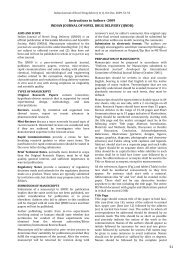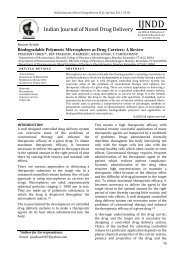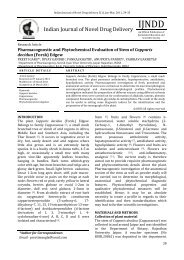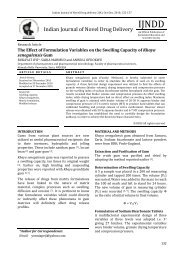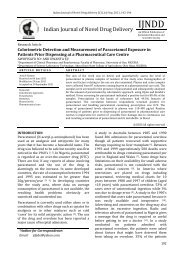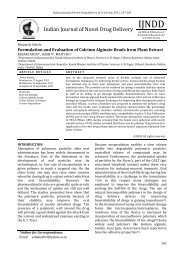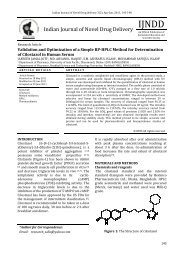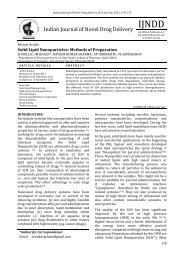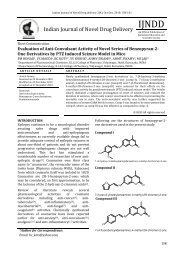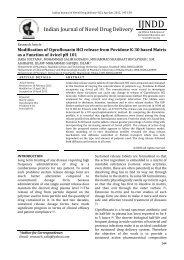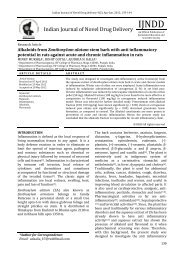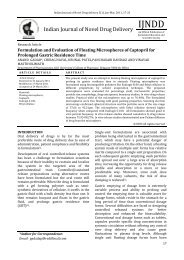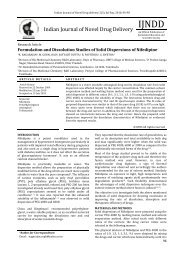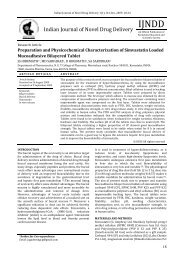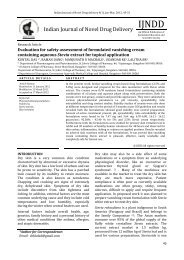Investigation of the Anti-Ulcer Activity of Chloroform Leaf Extract of ...
Investigation of the Anti-Ulcer Activity of Chloroform Leaf Extract of ...
Investigation of the Anti-Ulcer Activity of Chloroform Leaf Extract of ...
Create successful ePaper yourself
Turn your PDF publications into a flip-book with our unique Google optimized e-Paper software.
Nwachukwu C. Daniel et al / Indian Journal <strong>of</strong> Novel Drug Delivery 4(1), Jan-Mar, 2012, 52-56<br />
<strong>Extract</strong>s from <strong>the</strong> leaves, seeds, fruits, barks and<br />
roots <strong>of</strong> medicinal plants have been used in <strong>the</strong><br />
preparation <strong>of</strong> infusions in traditional medicine.<br />
These infusions have been used to treat ailments<br />
ranging from common cold to malaria, liver<br />
cirrhosis, hypertension and so on. The active<br />
constituents contributing to <strong>the</strong> protective<br />
effects are <strong>the</strong> phytochemicals, vitamins and<br />
minerals [13] . One <strong>of</strong> such medicinal plants is<br />
Aspilia africana which has a folk line reputation<br />
as an anti ulcer remedy.<br />
Aspilia africana is a perennial herb varying in<br />
height from 60cm to about 1.5m depending on<br />
rainfall. It is a common weed <strong>of</strong> field crops in<br />
West Africa and sometimes found in fallow land<br />
especially <strong>the</strong> forest zones [14] . In Nigeria, it is<br />
variously known as “Oranjila” in Igbo, “Tozalin”<br />
in Hausa, “Yunyun” in Yoruba and “Edemedong”<br />
in Efik [15] . The plant is a weed grazed by cattle<br />
and sheep and is mostly used in <strong>the</strong> South-West,<br />
Nigeria, as food for rabbits and hares [16] . Aspilia<br />
africana is widely used in African folk medicine<br />
to stop bleeding, remove corneal opacities,<br />
induce delivery and in <strong>the</strong> treatment <strong>of</strong> anaemia<br />
and various stomachs complains. Infusion <strong>of</strong> <strong>the</strong><br />
leaves is taken by children and can also be mixed<br />
with clay as a medicine for stomach trouble [17] . It<br />
has been reported that <strong>the</strong> plant is effective<br />
against malaria infection [18] . The plant has been<br />
reported to possess anti-microbial [19] and antihaemostatic,<br />
antifertility [20] and antiinflammatory<br />
activity [21] .<br />
Its phytochemical analysis revealed that it is rich<br />
in flavonoids, saponin, tannins, alkaloid, sterols,<br />
terpens. The medicinal plant also contains<br />
vitamins: ascorbic acid, rib<strong>of</strong>lavin, thiamine, and<br />
niacin [17] .<br />
Allopathic drugs have been used to treat or<br />
manage gastric ulcer. Some <strong>of</strong> <strong>the</strong>se agents like<br />
proton pump inhibitors (e.g. esomeprazole,<br />
omeprazole), H2-receptor antagonists e.g.<br />
cimetidine have side effects and <strong>the</strong>re is a high<br />
incidence <strong>of</strong> ulcer relapse and drug interaction<br />
following <strong>the</strong> use <strong>of</strong> <strong>the</strong>se drug [22, 23] . Therefore,<br />
<strong>the</strong>re is need to evaluate medicinal plants with<br />
potential antiulcer properties since plant based<br />
drugs have been observed to be non-toxic and<br />
have little or no side effects12. The search has<br />
yielded good results as <strong>the</strong> antiulcer activity <strong>of</strong><br />
some medicinal plants has been scientifically<br />
validated [24-27]. Moreover, pharmacoeconomic<br />
considerations make it impossible for patients in<br />
low socioeconomic background to afford <strong>the</strong>se<br />
allopathic drugs. Consequently, <strong>the</strong>re is tendency<br />
to seek traditional medical care. We, <strong>the</strong>refore,<br />
decided to embark on this study in order to<br />
evaluate <strong>the</strong> gastroprotective activity <strong>of</strong> leaf<br />
extract <strong>of</strong> Aspilia Africana in experimentally<br />
induced gastric ulcer and contribute <strong>the</strong> on-going<br />
effort aimed at providing cheaper and better<br />
remedy for this disease.<br />
MATERIALS AND METHODS<br />
Animals<br />
Thirty-three male albino wistar rats weighing<br />
160-240g were used for <strong>the</strong> study. They were<br />
procured from <strong>the</strong> animal house, Department <strong>of</strong><br />
Physiology, College <strong>of</strong> Medicine, University <strong>of</strong><br />
Nigeria, Enugu Campus. The rats were kept in <strong>the</strong><br />
same environment under standard temperature<br />
condition (28±3 0 C) with12:12 hour light/dark<br />
cycle. They were fed with commercial grower’s<br />
feed (Guinea feed®Nig. PLC) and had free access<br />
to clean drinking water.<br />
Plant Materials<br />
Leaves <strong>of</strong> Aspilia Africana were collected from<br />
<strong>the</strong> premises <strong>of</strong> University <strong>of</strong> Nigeria, Nsukka and<br />
au<strong>the</strong>nticated by a taxonomist at <strong>the</strong> herbarium<br />
section <strong>of</strong> Department <strong>of</strong> Botany, University <strong>of</strong><br />
Nigeria. A voucher specimen with number<br />
UNH/315c was kept in <strong>the</strong> herbarium for future<br />
references. The leaves were dried under shade<br />
and milled using an electric blender.<br />
<strong>Extract</strong> Preparation<br />
1000g <strong>of</strong> powdered leaves <strong>of</strong> Aspilia Africana<br />
were soaked in 3 litres <strong>of</strong> chlor<strong>of</strong>orm for 72hours<br />
and strained with muslin cloth, <strong>the</strong>n filtered<br />
using Whatman no. 1 filter paper. The filtrate<br />
was allowed to dry in open air and a dark<br />
greenish extract was formed. 20g <strong>of</strong> <strong>the</strong> extract<br />
was dissolved in 10ml <strong>of</strong> 3% Tween 80 and made<br />
up to 100ml with chlor<strong>of</strong>orm.<br />
Phytochemical Analysis<br />
Phytochemical screening was carried out using<br />
<strong>the</strong> method <strong>of</strong> Trease and Evans [28] . This method<br />
is useful in determine <strong>the</strong> various constituents <strong>of</strong><br />
<strong>the</strong> plant and <strong>the</strong>ir pharmacological and<br />
toxicological effects [29] .<br />
Acute Toxicity Test<br />
13 male albino wistar rats were used for<br />
determination <strong>of</strong> LD50 as described by Lorke [30] .<br />
Aspirin induced ulceration<br />
20 male albino wistar rats were divided into four<br />
groups (A-D) <strong>of</strong> 5 rats each. The rats were<br />
starved for 24 hours prior to <strong>the</strong> commencement<br />
53



